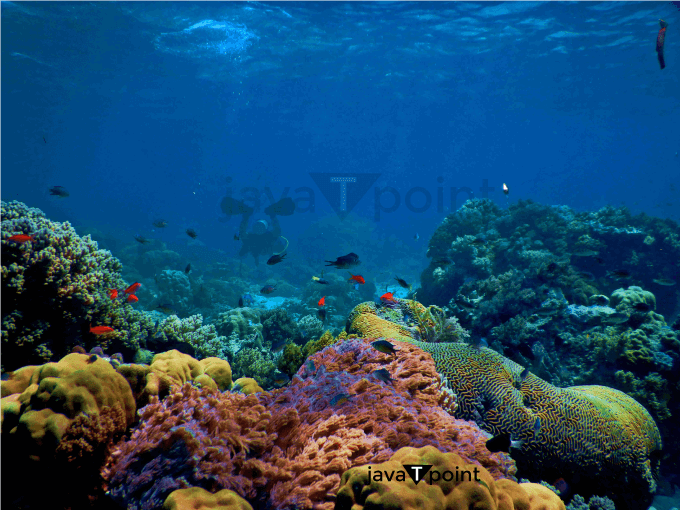Ocean DefinitionAbout 71% of the surface of the Earth is covered by the ocean, a huge body of saltwater and, it consists of about 97% of Earth's water. The hydrosphere, which also consists of lakes, rivers, and other bodies of water, includes it as a significant element. Any of the large water bodies that the world ocean is typically divided into can also be referred to as an ocean. The Atlantic Ocean, Pacific Ocean, Indian Ocean, Southern Ocean, and Arctic Ocean are the five main basins that make up the ocean. These basins are linked together to create a continuous body of water that encircles the entire planet. The depth and size of the ocean, which averages over 3,800 meters (12,500 feet), are what make it unique. It has a variety of features, including plateaus, ridges, trenches, and underwater mountains. The ocean also has a wide variety of ecosystems, from deep-sea regions with unusual and frequently undiscovered creatures to shallow coastal habitats abundant in marine life. Two of the deepest regions of the Pacific Ocean are the Mariana and Philippine Trenches, whose depths are even greater than the 8.84 km peak height of the Himalayas. 
Oceanography and OceanographersOceanographers are the ones who study and do research on the oceans. They are a special kind of scientists. The study of the ocean and all of its intricate connections to the Earth is known as oceanography. This covers the study of the weather, ocean currents, marine life, and all other subjects of the ocean. Oceanographers believe that the marine ecosystem is depleting in the ocean because of sea-level rise, water pollution, increase in sea temperature, etc., resulting in a decrease in the number of species. Oceanographers come from many areas of research.
Different Types of OceansThe Pacific Ocean, Atlantic Ocean, Indian Ocean, Atlantic Ocean, and Arctic Ocean are the main five oceanic divisions and each of them has its unique characteristics. 1. Pacific OceanThe largest and deepest ocean on Earth is the Pacific Ocean. It reaches the eastern shorelines of Asia and Australia from the western coast of the Americas, which includes North and South America. Features:
2. Atlantic OceanThe Atlantic Ocean is the second-largest ocean in the world, which stretches between the western coastlines of Europe and Africa and the eastern coastlines of the Americas. Features:
3. Indian OceanThe Indian Ocean is the third largest ocean and is located between Asia, Australia, and Africa. Through the southern tip of Africa, the Southern Ocean links the Indian Ocean to the Atlantic Ocean. Features:
4. Antarctic OceanAlso known as the Southern Ocean. Some oceanographers referred to the waters surrounding Antarctica as the Southern Ocean during the 20th century. It stretches from Antarctica's coasts to a latitude of roughly 60 degrees south. Features:
5. Arctic OceanOf the five oceans, it is the smallest and shallowest. The majority of the Arctic Ocean is always covered in ice. It is located around the North Pole in the Northern Hemisphere. Features:
Importance of OceanThe ocean is incredibly important to our world because it sustains life in many different ways and is essential to preserving the ecosystems on Earth. Here are some crucial ideas emphasizing the significance of the ocean: 1. Climate Regulation:The ocean is a key factor in determining the Earth's climate since it regulates temperature and weather patterns, and stores and distributes heat. Furthermore, it serves as a huge carbon sink, soaking up and storing carbon dioxide from the atmosphere to lessen the effects of climate change. 2. Production of Oxygen:The ocean is the planet's life support system since it covers 72 percent of its surface and provides half of its oxygen. Marine plants, particularly phytoplankton, provide a significant portion of the oxygen in the atmosphere through photosynthesis. The oxygen levels in the Earth's atmosphere are increased by these microscopic organisms, which makes the ocean essential for supporting life on our planet. 3. Biodiversity:It is home to many different types of species of flora and fauna. Coral reefs, marine mammals, countless fish species, and different types of microbes are just a few of the diverse living forms that it sustains. It is essential for preserving ecological harmony and the world's biodiversity. 4. Food Security:A vital source of food for billions of people globally is the ocean. It contributes a sizeable share of the protein consumed globally, with fish and other seafood being a staple in many diets. 5. Ecological Significance:Oceans are essential to world economies. Numerous sectors, including fishing, shipping, tourism, and offshore energy generation, are supported by it. Particularly in coastal regions, these sectors have a considerable impact on employment, commerce, and economic growth. 6. Trade and Transportation:In addition to its ecological significance, the ocean is critical to the world's economy and transportation because it makes international trade possible and provides a crucial route for ships and communication cables. 7. Natural Resources:A major source of natural resources like oil, minerals, fish, and gas are also found there, along with food and energy. 8. Scientific Research:It is believed by scientists that there are a vast number of marine species that are still undiscovered and unidentified. To gain a better understanding of the global climate systems, scientists examine the ocean's currents, temperature fluctuations, and circulation patterns. This study assists in anticipating the effects of climate change and enhancing weather forecasting models. Marine Species found in The OceansA wide variety of marine creatures, including fish, mammals, reptiles, birds, crustaceans, and many kinds of marine plants, can be found in the ocean. Here are a few marine species that can be found in the ocean: 
Animal SpeciesSome of the marine animal species are listed below: 1. Killer Whale It is among the top most dangerous predator in the ocean, also known as Orca (Orcinus). It is the largest dolphin in the family Delphinidae. All dolphin species as well as other bigger species like long-finned and short-finned pilot whales, whose common names also contain "whale" instead of "dolphin," are members of this family. Because of their unique black-and-white appearance, they are among the most easily recognized marine mammals. Killer whales can be found in every ocean in the world and in a variety of environments, including inland and coastal waterways. 2. Jellyfish Jellyfish are not technically fish; rather, they are invertebrates or non-bony animals. Golden jellyfish is its common name. They are in different shapes, sizes, and colors. All the oceans of the world, from the Arctic to the Antarctic, and everywhere in between, are home to jellyfish. They can be found in both warm and cold waters and are not specific to one ocean. 3. Flower Urchin Echinodermata is the name of a group of creatures that includes sea urchins. One trait unites all sea urchins: its test, a tough outer skeleton to which several sharp spines are attached. The spines serve as a line of defense. However, spines are not the common factor which makes them deadly or poisonous. In the Indian and Pacific waters, flower urchins are typically found near reefs. The echinoderm family, which includes sea stars, sea lilies, and sea cucumbers, is extremely diverse and unusual. 4. Tiger Pistol Shrimp The Alpheidae family of crustaceans (a diverse group of shrimps) includes Alpheus bell-ulus, also known as the tiger pistol shrimp. This prawn is known to live in harmony with goby fishes and typically feeds on leftover food. The prawn makes a loud noise that warns the fish it lives with to flee the danger. This prawn has an unusually designed claw that may produce a strong shock wave. Even though the animal is small, it has a potent weapon that may sometimes kill an opponent while also protecting itself. 5. Blue Dragon Blue dragon belongs to the sea slug species. This 3-cm-long snail has remarkable features that enable it to float in the water despite its diminutive size. It resides in the water column, drifting in the oceans of the Atlantic, Pacific, and Indian. It is extremely deadly since it has a lot of poisonous cells. Plant SpeciesSome of the marine plant species are as follows: 1. Phytoplankton The term "phytoplankton," which refers to microscopic, photosynthetic creatures that drift in bodies of water like seas, lakes, and ponds, is an important component of both marine and freshwater ecosystems. They are a diverse group of algae and cyanobacteria that are essential to the functioning of Earth's ecosystems and serve as the base of the aquatic food chain. Phytoplankton utilizes carbon dioxide, releases oxygen, and transforms minerals into a form that organisms may use, just like land plants does. The lakes and ponds are colored by the presence of green algae in large amounts and the bacteria there may change the flavor of the water. 2. Seagrass Except for Antarctica, all continents are home to seagrass, the only maritime blooming plant. They grow flowers and fruits and have stems, roots, and leaves. There are 14 different species of seagrass in India, which is in the Indo-Pacific area. A habitat where life can flourish is created when dense seagrass growth traps nutrients and moving silt. 3. Red Algae Red algae are a group of freshwater and marine algae also referred to as Rhodophyta. Despite being very uncommon in freshwater, they are common in marine settings. Because of the presence of pigments, red algae have a unique red or purplish color that gives them their name. Red algae can, however, come in a variety of colors, including green, brown, and even blue. Additionally, they support the overall stability and health of coral reef ecosystems. 4. Kelp Large brown algae or seaweed are known as kelps. With some species growing as tall as 150 feet (45 meters), kelp is well-known for its towering height. Kelp is not a plant, despite the way it looks. It is comprised of blades, which are flat or leaf-like structures. The stipes, which are lengthy, stem-like structures, are where blades emerge from. In shallow waters, kelp develops in "underwater forests" (kelp forests). Kelp forests are extremely significant ecosystems, kelp forests provide food and habitat for a wide variety of marine creatures.
Next TopicPharmacists Definition
|
 For Videos Join Our Youtube Channel: Join Now
For Videos Join Our Youtube Channel: Join Now
Feedback
- Send your Feedback to [email protected]
Help Others, Please Share










